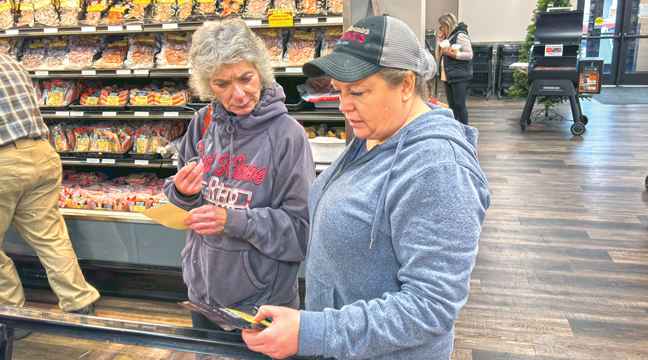In just six short months, Sherburne County residents should be able to get their first glimpse of the new park being developed along the north shore of Big Elk Lake in Palmer Township.
Totaling 430 acres, the parcel will eventually become the county’s largest park, with natural landscapes, walking trails and numerous interpretive elements aimed at honoring the land’s Native American cultural significance.
Honoring that heritage is a tall task that has helped guide Sherburne County’s Parks Director, Gina Hugo, as she leads a committee charged with developing the park.
Sacred Place
Hugo and other county leaders knew the area had been important to Native American tribes, and a pledge for cultural sensitivity has been at the forefront of the development plans since the county began working to acquire the site in 2019.
“From the very beginning, we knew it was a culturally significant site... so we reached out to the 11 Tribal Nations in Minnesota and asked them to be involved in the process,” Hugo says. “Initially, five of the groups responded back and three have remained very engaged in the process.”
Hugo says that the key to the appropriate development of the parcel has been simply to listen.
“We are continuing to listen and adjust our plans based on what we learn about their cultures,” Hugo says of the Ojibwe and Dakota representatives who have been a part of the process. “This also includes a Traditional Cultural Place survey that is being done through a partnership with the Lower Sioux Indian Community, the Upper Sioux Community and the Mille Lacs Band of Ojibwe. Funded through a Minnesota Historical Society Legacy grant, the survey will evaluate the property for placement on the National Register of Historic Places.”
This survey includes interviews with Tribal elders, spiritual healers and other Native descendants who will help determine exactly where the trails are located, as well as the interpretive amenities that will highlight the park.
“For me, it’s spiritual... and honoring the cultural significance of this place was a deliberate decision made by the county board and our staff,” says Commissioner Lisa Fobbe, a member of the Big Elk Lake Park Development Committee. “It’s an honor to own this property and to be the stewards of developing it and planning it.”
Development
The development committee is made up of Hugo and other county staff, Commissioners Fobbe and Gary Gray, as well as local representatives such as Palmer Supervisor Steve Demeules. There’s also the Tribal partners, who are on site during any work to consult with the contractors by answering questions and offering protocols to ensure appropriate care is taken during the sometimes delicate work.
Hugo says that the first phase of site preparation will entail the de-construction of between 10 and 15 structures on the property that are essentially falling apart.
Over the past 100 years, many structures were built on the site, including a dairy barn put up in 1916 by Claude Lewis, the first known settler on the property. There were also poultry operations and pheasant farming conducted on site over the past century.
But what is also known is that Native Americans used the land previous to that time for a variety of activities, including cemetery areas that are protected under the Private Cemeteries Act (Minnesota Statutes 307.08). That’s where the delicacy comes into play.
“In our world, we would just bulldoze it all down and haul it away,” Fobbe says. “But we are doing it differently, taking our time and listening to input from our Tribal partners.”
To the greatest extent possible, building materials from the structures will be salvaged for repurposing or recycled, to minimize the amount going to the landfill. In addition, as structures are removed, this may lead to the discovery of more culturally sensitive areas that will require Tribal consultation and appropriate protections.
Timeline
So far, development at the site has included some general clean-up, as well as the seeding of 52 acres of native prairie this past spring. In early August, the de-construction of some structures will commence and work will start on the trails that will take visitors through that original prairie restoration.
“In some cases, the grant funding we have received is driving our timeline,” Fobbe explains.
“By December, we plan to have trails open through those first acres of native prairie that has been established.”
With an additional 78 acres of the prairie expected to be seeded in the spring of 2024 and then 32 more acres south of the Elk River slated perhaps for 2025, that will add another 110 acres restored to what it might have looked like more than 100 years ago.
“From there, we will continue to add and develop as funding allows,” Hugo says. “We will eventually move on to Oak Savanna restoration, as well as enhancing shoreline and flood plain forest management. These restoration practices are funded through grants from the Lessard Sams Outdoor Heritage Fund.”
Funding
Fobbe credits Hugo’s creativity and knowledge of applying for and receiving grant funding as a contributing factor in making the park a reality.
“I go back to nearly five years ago when the board decided the county was at a size that we needed a staff person to lead our parks,” Fobbe says. “Gina came on board in 2019 and has done a fabulous job of helping us to find funding for this project.”
Hugo credits the contribution from the Trust for Public Land in helping the county to acquire the property in the first place, calling them an “important partner.”
Two major infusions of funding have helped the project, including $1.25 million through the Greater MN Regional Parks and Trails Commission (legacy money from the 2008 MN constitutional amendment) and $500,000 from the Environmental and Natural Resources Trust Fund (from the 1988 MN constitutional amendment directing lottery proceeds).
The Park Department’s local match was made possible through the partnership with the County Planning and Zoning Department, whose resources and knowledge navigating the solid waste mitigation have been invaluable.
Fobbe says the project is turning heads in Minnesota, as well as nationally.
“I’ve been to Washington, D.C. sharing this story with our congressional delegation and it piqued their interest,” Fobbe says. “We have also spoken with the Bureau of Indian Affairs and the Department of the Interior... they are both appreciative of how we are approaching this project.”
The Future
At the anticipated opening of the first public trail loop in December, both Fobbe and Hugo will take satisfaction in knowing that the hard work is starting to pay off for the residents of the county.
“This project came across my desk just after I was hired by the county,” Hugo says. “It’s an amazing place and will allow people to connect with nature in the form of trails, interpretive features and native plant populations.”
Fobbe sees the chance to get more people in the great outdoors, but also in perhaps setting a new standard for how parks are developed.
“This is definitely a unique and culturally significant place and as we’ve shared our story, we’re finding our work could set a precedent for others to follow,” Fobbe says. “No one else has really done it in the way we have and we are proud of that.”







